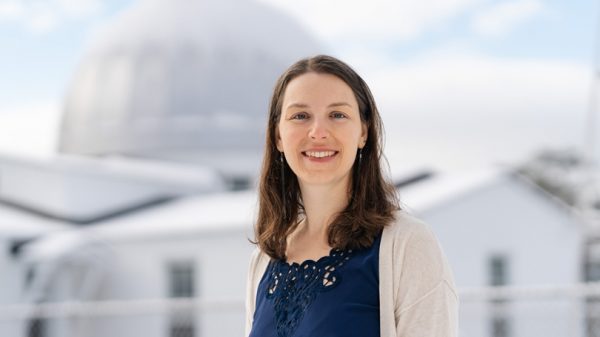A Berkeley High grad, now a professor of astronomy, discovers a new planet – Berkeleyside

Elisabeth Newton, a Berkeley High graduate who is currently an assistant professor of physics and astronomy at Dartmouth College, was the leader of a research team that recently found an exoplanet — a planet outside our solar system.
Newton, who went to college at UC Santa Barbara and got her Ph.D. in physics from Harvard University, expects that this major discovery will yield valuable knowledge about how planetary systems form and change.
“One of the overall goals of astronomy is understanding the big picture of how we got here, how solar systems and galaxies take shape,” says Newton. “By finding solar systems that are different from our own — especially young ones — we can hope to learn why Earth and our own solar system evolved in the ways that they did.”
The planet, called DS Tuc Ab, orbits a bright young star. The star has been well studied, but the planet had been previously unknown. And even though DS Tuc Ab is about 45 million years old, it’s just a preteen, in astronomical terms. Now six times bigger than Earth, between the sizes of Neptune and Saturn, DS Tuc Ab is no longer growing, but it is still evolving. It’s thought to have a large gaseous envelope and be losing atmospheric gas, which means that it could shrink over time.
DS Tuc Ab was first observed as part of NASA’s Transiting Exoplanet Survey Satellite (TESS) mission in November 2018 and was confirmed in March by Newton’s research team, which includes scientists from the University of North Carolina at Chapel Hill, the University of Texas at Austin, and other research centers from around the world. TESS looks for exoplanets that block the light of the stars they orbit, as they pass between Earth and the host star.
“What we had was evidence that every eight days, DS Tuc Ab’s star briefly dimmed in a way that looked like it could be caused by a planet crossing in front of it,” says Newton. Next, the team had to narrow down the cause for that variation in brightness. “There are a number of false-positive scenarios we had to rule out,” Newton says.
For example, the dimming could have been caused by the movement of binary stars rather than a planet. Also, telescopes create instrumental “noise” that could distort the measurement of brightness.
“It took a lot of data to arrive at our conclusion that there wasn’t another star in the background,” says Newton. Some of that data came from the Southern African Large Telescope (SALT), to which Dartmouth has access. “If you have binary stars, SALT allows you to detect them moving back and forth. But in this case, we didn’t see evidence of that. We saw only one star.”
Newton clearly remembers the day—actually, the night—she and her team first saw the signal of DS Tuc Ab.
“I was in South Africa at a SALT conference, Skyping back to my colleagues in the U.S. around midnight. It was a very long email train,” Newton recalls.
“We weren’t exactly shocked, because this was what we had set out to find. But we were surprised at how young it is, and how bright the star it orbits is. Most of the planets being found by the transit method are much older and orbit faint stars. So we were really excited when we confirmed this discovery because the planet orbits such a bright, well-known young star.”
The discovery of the exo-planet prompted excitement, including this tweet from Jeff Sharlet, an associate professor of English at Dartmouth. His Netflix Series, “The Family” about a secretive religious cult, is getting a lot of attention.
So I’ve got this new Netflix series, but meanwhile my @dartmouth colleague @EllieInSpace just discovered a new *planet,* awesomely named DS Tuc Ab. So that kinda puts things in perspective. #realresearch https://t.co/XM9PsaZ1ic
— Jeff Sharlet (@JeffSharlet) August 15, 2019
The study of exoplanets is expanding knowledge about how planets are built, Newton says. Scientists are learning that the construction process varies more than previously thought.
“A lot depends on the disk of materials out of which it forms. It depends on interactions between planets. It depends on the interaction of the planet with the disk. So all this is leading us to reassess our own solar system. We used to think that our solar system was very well ordered, that it was formed exactly the way it is, but there’s a current model suggesting more chaotic interactions are at work,” says Newton.
Newton’s team made the DS Tuc Ab discovery, which was announced last month in the journal “The Astrophysical Journal Letters,” shortly after she joined Dartmouth’s Department of Physics and Astronomy.
When she’s not peering through telescopes or sifting through reams of data, Newton reaches for heights in a different way—by rock climbing.
“Another reason I love living in Northern New England,” she says, “is that there’s not much light pollution, so you can usually see the stars at night” — a matter of no small importance.
A version of this article originally appeared in Dartmouth News. The author can be reached at charlotte.e.albright@dartmouth.edu






